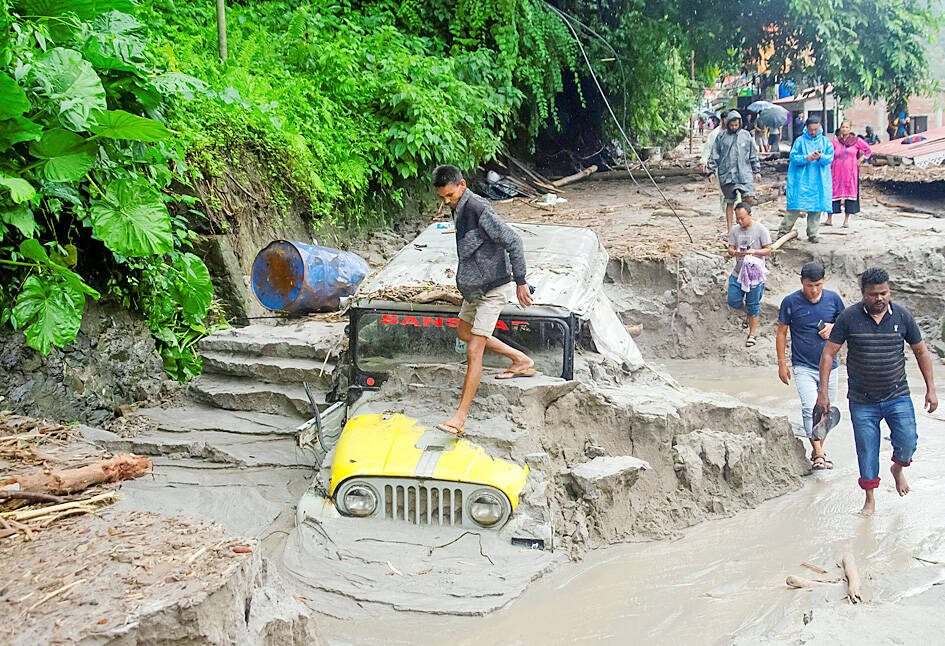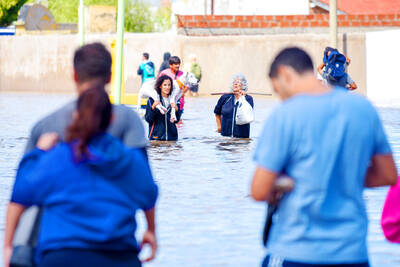At least 56 people are confirmed dead in floods that hit India’s northeast as of yesterday, with the army warning that munitions washed away by the deluge posed a public safety risk.
Violent torrents struck Sikkim state on Wednesday after the sudden bursting of a high-altitude glacial lake.
Climate scientists say that similar disasters would become an increasing danger across the Himalayas as global temperatures rise and ice melts.

Photo: Reuters
“So far 26 bodies have been found in Sikkim,” Sikkim State Relief Commissioner Anilraj Rai said.
Thirty more bodies had been recovered from the Teesta River basin by search-and-rescue teams downstream in neighboring West Bengal state, Jalpaiguri District Police Superintendent K. Umesh Ganpat said.
“The river stretches up to 86km,” he added. “The search operation is continuing.”
Among the dead are seven Indian army soldiers posted in Sikkim, which sits on India’s remote frontiers with Nepal and China, and boasts a sizeable military presence. Sixteen soldiers are among the more than 100 people still missing.
The Indian Ministry of Defense said in a statement that the floods had washed away “firearms and explosives” from military camps.
The army has “established lookout teams all along the river” to recover loose ordnance, the ministry added.
Local media reports on Friday said that two people had been killed and four others injured by a mortar shell that exploded while flowing through the flood waters in West Bengal.
Roads, bridges and telephone lines have been destroyed across much of the state, complicating evacuations and efforts to communicate with thousands cut off from the rest of the country.
More than 1,200 houses had been damaged by the floods, the latest Sikkim government bulletin said.
More than 2,400 people had been rescued, while nearly 7,000 were taking shelter at makeshift relief camps set up at schools, government offices and guesthouses, the bulletin said.
The water surge came after intense rainfall burst the high-altitude Lhonak Lake, which sits at the base of a glacier in peaks surrounding the world’s third-highest mountain, Kangchenjunga.
Water powered downstream, adding to a river already swollen by monsoon rains, damaging a dam and sweeping away houses.
Experts said that intense rain and a magnitude 6.2 earthquake that struck nearby Nepal on Tuesday afternoon might have contributed to damaging the dam.
A 2019 report compiled by the Sikkim State Disaster Management Authority identified Lhonak Lake as “highly vulnerable” to flooding that could breach dams and cause extensive damage to life and property.
Himalayan glaciers are melting faster than ever due to climate change, exposing communities to unpredictable and costly disasters, the International Centre for Integrated Mountain Development (ICIMOD) research group said.
“The root cause is climate change and this going to increase in the future,” ICIMOD climate change specialist Arun Bhakta Shrestha said. “Similar glacial lake outbursts flood events are very likely.”
Earth’s average surface temperature has risen nearly 1.2°C since pre-industrial times, but high-mountain regions around the world have warmed at twice that pace, climate scientists say.
Additional reporting by AP

ANGER: A video shared online showed residents in a neighborhood confronting the national security minister, attempting to drag her toward floodwaters Argentina’s port city of Bahia Blanca has been “destroyed” after being pummeled by a year’s worth of rain in a matter of hours, killing 13 and driving hundreds from their homes, authorities said on Saturday. Two young girls — reportedly aged four and one — were missing after possibly being swept away by floodwaters in the wake of Friday’s storm. The deluge left hospital rooms underwater, turned neighborhoods into islands and cut electricity to swaths of the city. Argentine Minister of National Security Patricia Bullrich said Bahia Blanca was “destroyed.” The death toll rose to 13 on Saturday, up from 10 on Friday, authorities

Two daughters of an Argentine mountaineer who died on an icy peak 40 years ago have retrieved his backpack from the spot — finding camera film inside that allowed them a glimpse of some of his final experiences. Guillermo Vieiro was 44 when he died in 1985 — as did his climbing partner — while descending Argentina’s Tupungato lava dome, one of the highest peaks in the Americas. Last year, his backpack was spotted on a slope by mountaineer Gabriela Cavallaro, who examined it and contacted Vieiro’s daughters Guadalupe, 40, and Azul, 44. Last month, the three set out with four other guides

Local officials from Russia’s ruling party have caused controversy by presenting mothers of soldiers killed in Ukraine with gifts of meat grinders, an appliance widely used to describe Russia’s brutal tactics on the front line. The United Russia party in the northern Murmansk region posted photographs on social media showing officials smiling as they visited bereaved mothers with gifts of flowers and boxed meat grinders for International Women’s Day on Saturday, which is widely celebrated in Russia. The post included a message thanking the “dear moms” for their “strength of spirit and the love you put into bringing up your sons.” It

DISASTROUS VISIT: The talks in Saudi Arabia come after an altercation at the White House that led to the Ukrainian president leaving without signing a minerals deal Ukrainian President Volodymyr Zelenskiy was due to arrive in Saudi Arabia yesterday, a day ahead of crucial talks between Ukrainian and US officials on ending the war with Russia. Highly anticipated negotiations today on resolving the three-year conflict would see US and Ukrainian officials meet for the first time since Zelenskiy’s disastrous White House visit last month. Zelenskiy yesterday said that he would meet Saudi Arabian Crown Prince Mohammed bin Salman, the nation’s de facto leader, after which his team “will stay for a meeting on Tuesday with the American team.” At the talks in the Red Sea port city of Jeddah, US